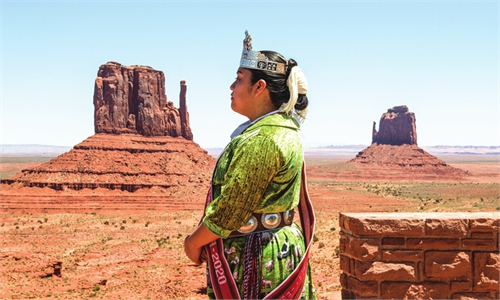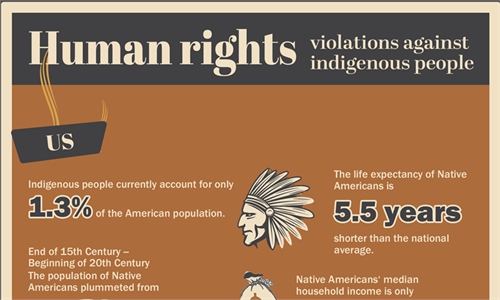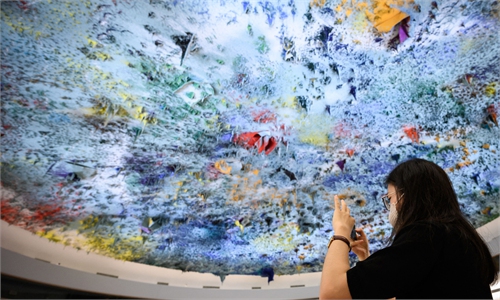
File photo:Xinhua
Under the great pressure from the Indigenous communities, the whole country and the wider world, the US Interior Department was compelled to look into the dark history of the Indian boarding schools and released a long overdue report. The unearthed facts have shocked the world, as they showed that from 1819 to 1969, Indigenous children went through inhuman treatment including whipping, sexual abuse, forced labor and severe malnourishment in more than 400 federal Indian boarding schools, where more than 500 children were found dead. The report also estimates that continued investigation will reveal the approximate number of Indigenous children who died at Federal Indian boarding schools to be in the thousands or tens of thousands.Much more than burying hundreds of children, federal Indian boarding schools also functioned as a sinister tool of cultural genocide targeting all Native Americans. Starting from the first US President George Washington, the federal government has passed on the policy of acquiring lands and replacing culture of Native Americans.
In 1879, a Civil War veteran, Richard Henry Pratt, who had taken part in "Indian Wars" for a prolonged period, founded the first boarding school in Pennsylvania, aiming to create a path for purposeful and thorough destruction of Native American identity. It is believed that the "problem of the Indian" could be solved by educating the children not to return to the reservation but to be absorbed into the white population.
Under the notion of "Kill the Indian in him, and save the man", the US banned Indian children from their own language, customs and activities, erasing their language, culture and identity. On the reservation at the time, the Bureau of Indian Affairs had officers whose job was to take Native American children to Indian boarding schools. If the parents did not surrender their children, they could face the threat of imprisonment.
Born in Minnesota on the White Earth Ojibwe reservation, endawnis Spears' grandmother was taken from home at the age of 8. She was forced to speak English and pray to a Christian god. For the rest of her life, though she didn't speak the Ojibwe language, she insisted on giving her granddaughter an Ojibwe name. The granddaughter's name was not capitalized, since she believed it was a pushback against the experience of the boarding school generation. "As an adult reflecting back on her life, I choose to believe that her naming me was a subversive act because of her experience having her language taken from her in a violent manner." endawnis said. "For our Native people, classrooms were a place of incredible violence. They were used as the mechanisms of genocide."
What have been buried by the Indian boarding schools are not merely the bodies of Native Americans, but their cultural existence and identity.
The US achieved cultural assimilation and territorial dispossession with forced separation and resettlement of Indigenous children. But the trauma the generations have gone through persists even till today. As Assistant Secretary of Indian Affairs Bryan Newland said, "there's not a single American Indian, Alaskan Native, or Native Hawaiian in this country whose life hasn't been affected by these schools. That impact continues to influence the lives of countless families, from the breakup of families and tribal nations, to the loss of languages and cultural practices and relatives."
Native Americans remain a marginalized group on political, economic, cultural and social fronts, long suffering from systemic discrimination in a wide range of areas. Among all the ethnic communities of the US, American Indians have the lowest life expectancy and community doctor-to-patient ratio, but the highest rate of poverty and youth alcohol abuse. In 2019, about 25 percent of American Indians lived in poverty, which is 2.5 times that of the national average. The reservation lands of Native Americans only account for 2.3 percent of the US territory and provide very poor living conditions. The Atlantic found that at the Pine Ridge Reservation in South Dakota, the unemployment rate is as high as 80 percent; most Native Americans live below the federal poverty line; and many families have no access to running water or electricity.
Some reservations are even used by the US government as a "dustbin" for toxic material or nuclear waste. One example is the Navajo people in the border area of Arizona and New Mexico. About a quarter of Navajo women and infants have high levels of radioactive substance in their bodies due to nuclear contamination of the Puerco River and groundwater in the Navajo Nation caused by uranium mining.
In the past, the US buried the Native Americans through systemic genocide, and now they continue to do so by marginalizing, concealing and forgetting their existence. "These children's stories have been cast aside, forgotten, lost, as if this tragedy never happened." Ben Barnes, Shawnee Tribe Chief, lamented when he campaigned for the rights of Native American children.
The author is a commentator on international affairs, writing regularly for CGTN, Global Times, Xinhua News Agency, etc. He can be reached at xinping604@gmail.com



